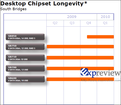Friday, April 17th 2009

AMD SB850 Southbridge to Pack Gen. 3 SATA 6 Gbps Support
As the market receives AMD's homegrown chipsets well since its successful 7-series, the company is preparing a new breed of platform core-logic technologies that will serve present and upcoming generations of the company's processors. From what we know so far, the company has designed the RD8xx and RS880, and has reportedly prepared prototype motherboards based on the chipsets. Several motherboard vendors have already prepared their upcoming SKUs based on the RS880 (AMD 880G), though all of these feature current SB710/SB750 series southbridge chips.
The successor, SB850, has been known to bring in an expanded feature set, and more importantly, an update with its storage controller. The southbridge will be one of the first ones to feature the third-generation SATA interface, that offers a maximum bandwidth of 6 Gbps between the system and the storage device, in comparison to 3 Gbps SATA II offers. In RAID mode, the controller will provide RAID 0, 1, JBOD, and RAID 5 modes. Six SATA channels will be supported in all. Other known features include support for 14 USB ports, albeit USB 2.0. AMD won't be embracing USB 3.0 just yet. The new southbridge will be released in Q4 2009 according to a portion of a roadmap slide by the company.
Source:
Expreview
The successor, SB850, has been known to bring in an expanded feature set, and more importantly, an update with its storage controller. The southbridge will be one of the first ones to feature the third-generation SATA interface, that offers a maximum bandwidth of 6 Gbps between the system and the storage device, in comparison to 3 Gbps SATA II offers. In RAID mode, the controller will provide RAID 0, 1, JBOD, and RAID 5 modes. Six SATA channels will be supported in all. Other known features include support for 14 USB ports, albeit USB 2.0. AMD won't be embracing USB 3.0 just yet. The new southbridge will be released in Q4 2009 according to a portion of a roadmap slide by the company.

37 Comments on AMD SB850 Southbridge to Pack Gen. 3 SATA 6 Gbps Support
Seriously, 12 wasn't enough?
Very good news with the new SATA standard though, SSDs are rapidly approaching fully saturating a SATA II channel.
forums.techpowerup.com/showthread.php?p=697422#post697422
And SATA 6Gbps instead of USB 3.0? Hmmm, which one is likely to be more useful to consumers?
Now what I assume you mean is they don't have a $1000 processor to go toe to toe on air/watercooling against the i7 965/975. That is true, but I would like you to tell me exactly how many people are spending 1k on a processor. I see you only have a Q6600, so I don't really understand the point of view as that processor wasn't ever $1000.
At average prices the PII lineup is fantastic, they hang with the i7 920 just fine excluding HT, and they offer a cheaper chipset.
If I wanted variable speeds and high resource usage, then I'd use USB.
It's a shame all the companies are cheap asses and don't want to provide superior technology on their products. I'll easily pay the few dollars it costs for the interface. It's valuable. 12 USBs even if they're USB 3.0 are not.
Flame away.
Oh, and I want hardware raid 5 and improved 1 and 0 performance. What happened to using SI chips on the MBs? Those are far superior to any of this integrated crap. And what's with the raid drivers on the GF8200 MBs? The raid controller thinks the volume always get degraded, pathetic.
Besides, more USB ports isn't that useful. The USB standard says on USB root hub can handle more devices than it has ports for. For example my SB700 can handle 12 direct attached ports, but if I take a look in the device manager and count how many devices each hub can take, I find it can handle 26 USB devices. A simple USB hub for usual devices like a flash stick, printer or and external drive will give me the additional ports that I would need... if I would need so many. Not mentioning that some LCD's now come with such hubs build in. Dell's 2408WFP has 4 USB-A for output and a five-format card-reader from one USB-B for input.
Anyway... I hope there's more to it than more USB's and SATA 6 Gbit/s.
I don't know, but having a SATA on-chip controller or as a separate chip is more than enough for a technology to enable and achieve hi speed transfers. I don't know what else could be the purpose of having a more stressful tech (USB 3.0) on the same chip besides the another tech (SATA) that can already do the same thing?
And it's eSATA, with a lower e.
Now, tons of tiny files can be an exception. Idk what causes it (windows maybe?), but those write slow as hell, less than 1 MB/s (on flash drives).